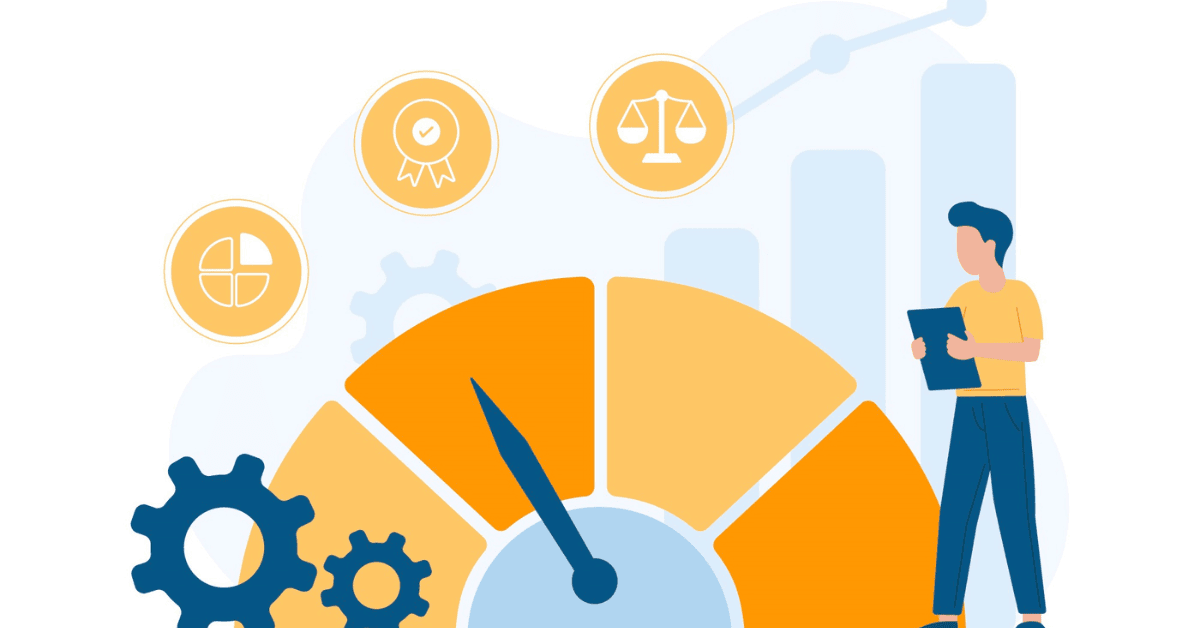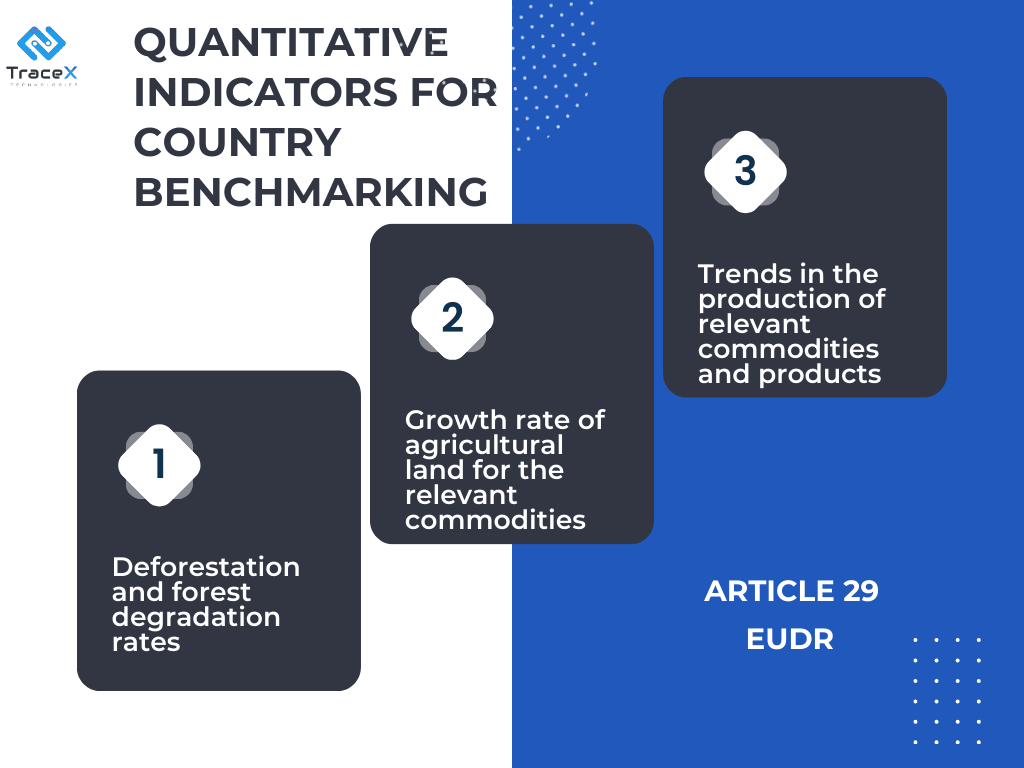Contact: +91 99725 24322 |
Menu
Menu
Quick summary: Discover how country benchmarking in EUDR risk assessment helps businesses identify high-risk regions for deforestation and implement effective compliance strategies to meet the EU Deforestation Regulation (EUDR) requirements.

When it comes to safeguarding global forests, the stakes couldn’t be higher. For companies trading in commodities like soy, palm oil, and coffee, the EU Deforestation Regulation (EUDR) introduces new challenges—and opportunities. One of the biggest pain points is ensuring compliance while navigating the complex global supply chains. Country benchmarking in EUDR empowers businesses to streamline their due diligence and avoid high-risk areas, making compliance less daunting and more manageable.
By categorizing countries based on deforestation risks, Country Benchmarking simplifies compliance efforts, helping businesses ensure that their operations align with the EU’s zero-deforestation goals.
The EUDR applies to commodities such as soy, palm oil, beef, cocoa, coffee, and wood, among others. The regulation not only ensures that companies sourcing from these regions uphold zero-deforestation standards but also enables EU buyers to make more informed sourcing decisions. At the core of this effort is the benchmarking system, designed to assess and classify countries based on their risk of deforestation.
Key Takeaways
Country benchmarking under EUDR is a risk assessment framework that categorizes countries into three groups: low-risk, standard-risk, and high-risk based on their deforestation and forest degradation levels, alongside governance factors such as law enforcement and adherence to international standards.
This tiered approach, based on the EC’s risk rating, ensures stricter enforcement for higher-risk regions.
By ranking countries according to these benchmarks, the EUDR Compliance aims to guide companies in their due diligence efforts, offering clear guidelines on risk mitigation, geolocation requirements, and traceability.
According to this regulation, the European Commission is set to create a three-tier benchmarking framework to categorize commodity-producing nations and regions as low, standard, or high risk (Article 29). Upon the EUDR’s implementation on 29 June 2023, all nations were designated as standard risk. Within 18 months, the Commission will assess and categorize these countries and their regions as either low or high risk, making this classification public. This framework will allow regulators to focus their inspections on goods from high-risk areas, while operators can conduct streamlined due diligence for products originating from low-risk

The benchmarking process evaluates countries based on several criteria, all contributing to their classification. Here are the core factors that influence the risk categorization:
1. Deforestation Rates: A country’s deforestation history, particularly concerning agricultural expansion, illegal logging, and land-use changes.
2. Land Governance: Legal frameworks for land use, environmental conservation, and protection of indigenous land rights.
3. Compliance with International Standards: Adoption of and adherence to global environmental standards, such as the Paris Agreement, UN REDD+ programs, and sustainable forestry initiatives.
4. Data Transparency and Accessibility: The availability of robust, transparent data on forest cover, land ownership, and commodity production.
5. Governance and Law Enforcement: The strength of institutions in enforcing laws related to deforestation, land rights, and environmental protections.
Countries that score well on these indicators are likely to be classified as low-risk, while those struggling with governance or high deforestation rates may be classified as high-risk.
As per the Regulation, the evaluation may also consider additional factors such as (a) input from governments and third-party organizations (e.g., NGOs, industry representatives); (b) agreements or other arrangements between the impacted country and the Union and/or its Member States regarding deforestation and forest degradation; (c) the presence of national legislation aimed at combating deforestation and forest degradation and its enforcement; (d) the accessibility of transparent data within the country; (e) if applicable, the existence and enforcement of laws that safeguard indigenous peoples’ rights; and (g) any international sanctions imposed by the UN Security Council or the Council of the European Union concerning the trade of the relevant commodities and products, among others.
Countries classified as high-risk face stricter scrutiny under the EUDR. Companies sourcing from these regions must perform enhanced due diligence, provide precise geolocation data, and often invest in direct partnerships with local suppliers to mitigate risk. High-risk classification can have wide-ranging impacts on the country’s trade relations, as businesses may avoid sourcing commodities from these regions to minimize compliance costs and reputational risks.
Both countries have historically faced high rates of deforestation due to palm oil production. Under EUDR, they may be classified as high-risk, requiring stricter due diligence and encouraging shifts toward certified sustainable palm oil (CSPO).
The Amazon’s deforestation, driven largely by soy farming, may lead to parts of Brazil and neighboring countries being classified as high-risk. As a result, companies may need to shift to low-risk areas or adopt certified sustainable practices.
For countries classified as low-risk, EUDR presents a unique opportunity. Their sustainable practices and robust governance models can attract more business from EU-based companies seeking to minimize compliance costs and adhere to green policies. Low-risk classification acts as a selling point, promoting these countries as leaders in sustainability.
Costa Rica, with its commitment to reforestation and sustainable agricultural practices, may be classified as low-risk. This status could boost its exports of sustainable coffee and timber products to the EU.
The EU and its Member States are enhancing collaboration with partner nations, including both consumer and producer countries, to tackle deforestation and forest degradation through a global Team Europe Initiative on Deforestation-free Value Chains. This TEI initiative will establish partnerships and cooperation mechanisms to assist countries in combating deforestation and forest degradation where a need is identified and a willingness to collaborate exists. For example, efforts will focus on supporting smallholders and businesses in maintaining deforestation-free supply chains. The Commission has already initiated projects aimed at spreading information, raising awareness, and addressing technical issues through workshops for smallholders in the most impacted third countries.
The EUDR’s benchmarking process is not just about classifying countries—it also aims to foster partnerships and build capacity in regions struggling with deforestation. The EU works closely with partner countries to improve governance, provide access to technology like satellite monitoring, and support smallholders in adopting sustainable farming practices.
To navigate the EUDR’s complex risk assessment and due diligence requirements, businesses need to adopt best practices that ensure compliance and reduce their environmental impact.
1. Implement Comprehensive Traceability Systems: Businesses should integrate digital traceability tools, such as blockchain, to monitor their supply chains in real time. These systems help maintain transparency and ensure that commodities are sourced from compliant, low-risk regions.
2. Engage in Direct Supplier Partnerships: By building long-term relationships with suppliers, businesses can have greater control over their supply chains, encouraging sustainable practices and improving compliance with EUDR standards.
3. Invest in Certification Programs: Many high-risk countries offer certification programs that verify the sustainability of specific commodities. Businesses can partner with organizations that provide certifications like Rainforest Alliance or Fair Trade, ensuring their sourcing practices align with global standards.
4. Develop a Proactive Due Diligence Framework: Rather than waiting for risk assessments to be mandated, businesses should proactively assess their sourcing practices and implement corrective measures, such as switching to certified suppliers or investing in sustainable production practices.
5. EUDR Reporting: The regulation requires traceability down to the source, transparency in reporting, and robust due diligence processes. For businesses exporting commodities like palm oil, coffee, or wood to the EU, accurate and timely EUDR reporting is essential to meet compliance and maintain market access, avoid penalties, and demonstrate commitment to sustainable practices.
Accurate country benchmarking would not be possible without modern technology. Geospatial data, satellite imagery, and blockchain technology all play vital roles in tracking deforestation, verifying sourcing, and ensuring compliance with EUDR requirements.
Real-time satellite data enables authorities to track deforestation and agricultural expansion. Satellite tools help verify claims made by companies about their supply chains, ensuring accuracy and reducing the risk of illegal practices slipping through unnoticed.
The integration of blockchain ensures that data related to product origins and supply chain movements are immutable and transparent. It allows for efficient traceability, particularly in high-risk regions where governance issues may obscure the true environmental impact.
Blockchain technology is set to be a game-changer in helping businesses meet the EUDR’s stringent compliance requirements. By offering immutable and transparent data tracking, blockchain provides the following benefits:
The TraceX EUDR Compliance Platform is a cutting-edge solution designed to help businesses seamlessly meet the European Union Deforestation Regulation (EUDR) requirements. Built on blockchain technology, it ensures secure, immutable, and transparent data tracking from farm to shelf. TraceX automates the collection and verification of geolocation data, streamlines risk assessments, and monitors land-use changes in real-time through satellite integration. As a differentiator, TraceX not only reduces the complexity of managing diverse suppliers but also offers end-to-end traceability, providing businesses with auditable proof of compliance. This platform enhances trust with consumers and stakeholders by demonstrating a strong commitment to sustainability.
Country benchmarking under the EUDR represents a significant step toward more sustainable, transparent supply chains. By categorizing countries based on deforestation risk, the EU helps businesses make informed decisions about sourcing, encourages sustainable practices in high-risk regions, and promotes better governance globally. As technology like satellite monitoring and blockchain continues to advance, businesses will have greater tools at their disposal to ensure compliance, protect forests, and contribute to the global fight against deforestation.
The future of sustainable trade lies in collaboration—between businesses, governments, and technology providers—working together to create a transparent, accountable, and environmentally responsible food system.
Country benchmarking in EUDR risk assessment is the process of evaluating countries based on their deforestation risk levels. This helps businesses identify high-risk regions where stricter due diligence is required for compliance with the EU Deforestation Regulation. The criteria are outlined in Article 29 of the Regulation
By comparing countries’ deforestation rates and environmental policies, businesses can prioritize risk assessments in high-risk areas, ensuring they meet EUDR requirements more efficiently. This allows for focused efforts on regions with greater deforestation concerns.
Factors such as deforestation rates, land-use policies, government enforcement of environmental laws, and historical land-use data are analyzed. These insights help businesses identify the countries where supply chains are most likely to pose deforestation risks.
